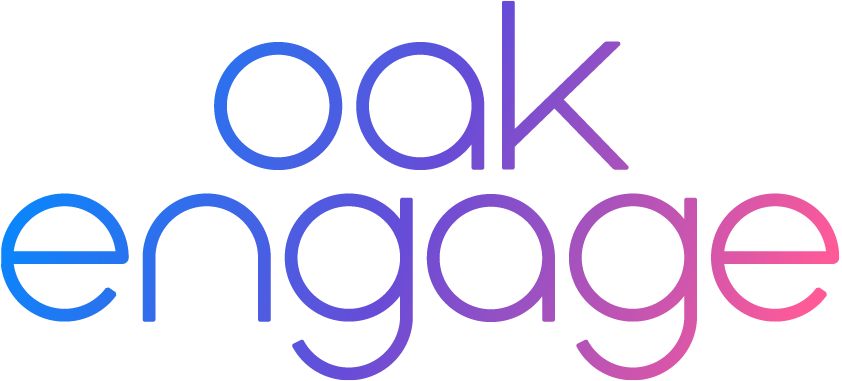Employee engagement and retention levels are two key factors within a business that employers often try to influence.
Business owners and managers need to keep their retention rates high in order to keep their employees engaged and grow their business.
If you can’t get employees to stay around for long, your business will always struggle to excel at long-term projects.
Ultimately, employee engagement and retention are interconnected and can determine the success of an organisation.
This blog will explore the importance of both and recommend tips and tricks to help employers improve engagement and retention in their company.
We will cover:
- Why is Retention Important?
- Why is Employee Engagement Important?
- The link between Employee Engagement & Staff Retention
- How to Improve Employee Engagement
Key Takeaways
⭐️ 87% of HR experts consider employee retention as one of the highest priorities in business.
⭐️ 92% of business executives believe that engaged employees perform better.
⭐️ Highly engaged workplaces saw 41% lower absenteeism.
⭐️ Engagement and retention are interconnected and can determine the success of an organisation.
Why Is Retention Important?
So, why is employee retention so important?
Legal Jobs found that 87% of HR experts consider employee retention as one of the highest priorities in business.
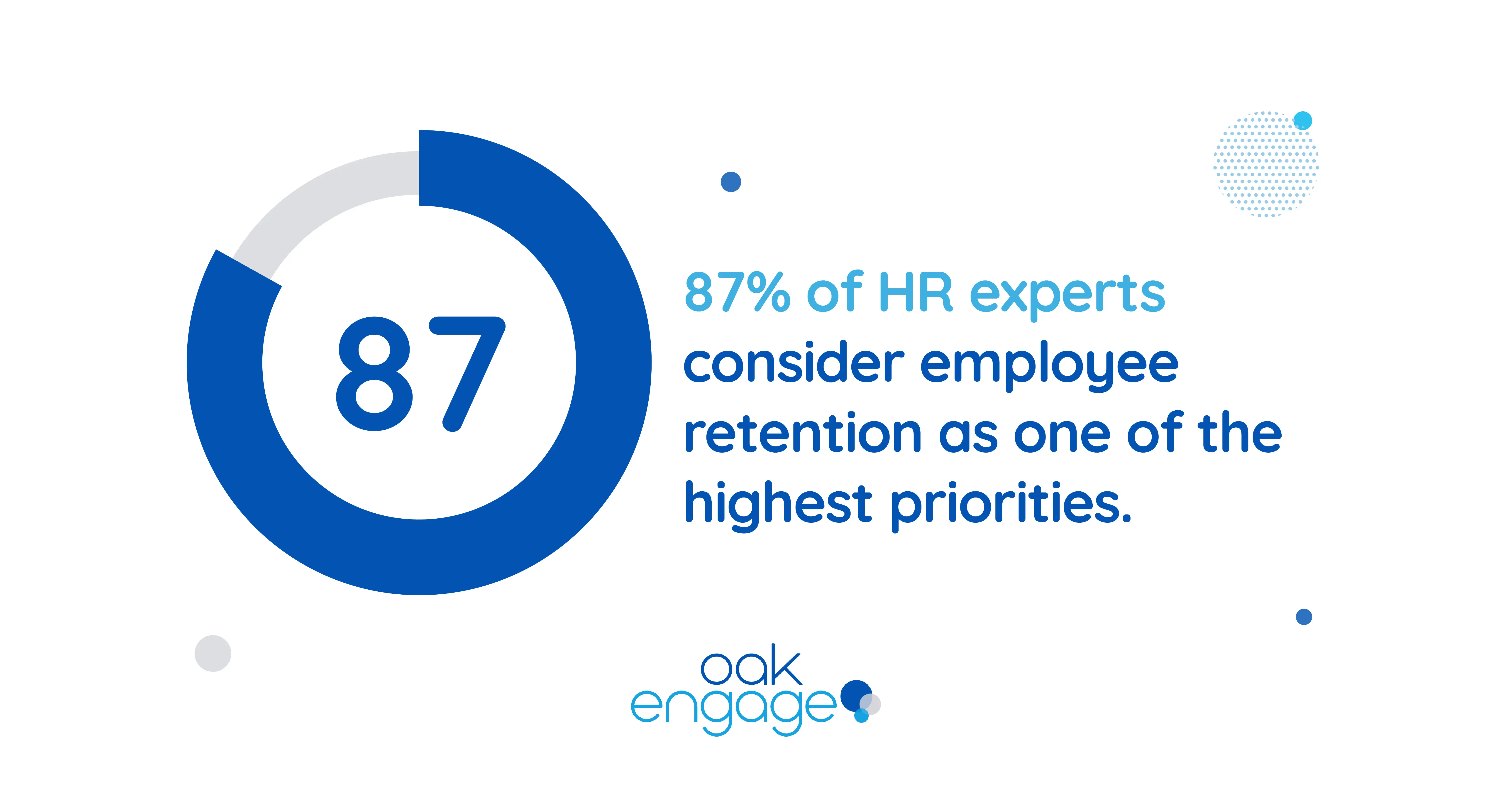
Companies who can retain employees experience up to 4x their profits. Not only are profits impacted but the cost of replacing employees can be astounding, with turnover costs of executives being as high as 213%.
But it’s not just costs that should concern businesses. Companies with high turnovers can experience a huge dip in productivity levels.
This can be incredibly disruptive for businesses. When experienced employees leave, it may take new employees a while to adapt and fill their shoes. Harvard Business review found that it can take around eight months for a new employee to reach full productivity.
High employee turnover can sometimes create an atmosphere where employees look for excuses to leave. It can almost be a catalyst for a chain reaction. Where when one employee leaves others seem to follow.
This can be incredibly detrimental to the morale of other employees who will feel the effects of progress as their teams are disrupted.
Employee retention brings with it a lot of benefits. If companies focus on retaining employees, keeping them engaged and looking after their wellbeing, they’ll certainly reap the rewards.
Increased retention results in greater productivity, profits, increased engagement and employee satisfaction.
Why Is Employee Engagement Important?
Research shows that 92% of business executives believe that engaged employees perform better, boosting the success of their teams and the outcomes of their business.
Sounds great, right?
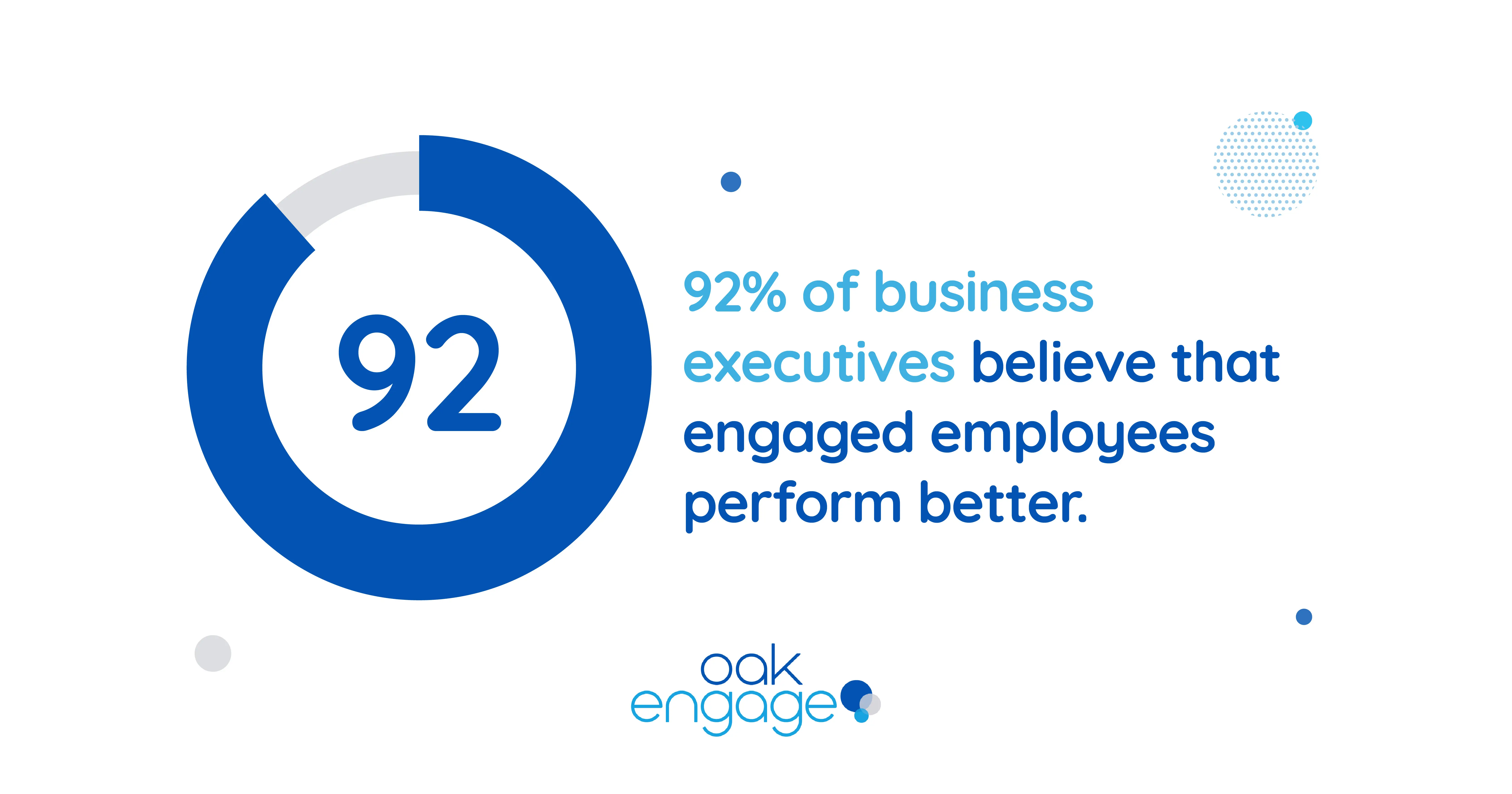
Well improving employee engagement is vital to any business, regardless of size or financial standing.
In fact, your employees are vital to the success of your business.
Whilst many companies may view their products as their biggest asset, they're failing to notice that their people are what make the cogs turn.
Companies that value their employees will reap the rewards of a dedicated, passionate and skilled workforce.
However, those that fail to nurture and reward their staff won’t get the most out of their people, regardless of how talented they might be.
Recommended Reading 📖: Why is Employee Engagement Important? (Key Benefits)
Since you’re reading this blog, you might be heading down this path.
But don’t worry! We’re about to send you on a journey full of tips and tricks.
Before we head straight into the steps you can use to skyrocket your engagement, let’s take a look at some benefits of improving workforce engagement.
Higher Employee Retention
Who doesn't want high employee retention?
Well engaged employees don’t have a reason to look elsewhere for work.
I know, it almost sounds too good to be true! (But it’s not!)
A company’s employee retention improves when:
- Employees know they will be recognised and appreciated for their contributions.
- Employees see opportunities for professional growth and career development.
- They understand when business change happens and why.
All of these factors help improve employee engagement and establish trust between the workforce and their employer.
Increased Employee Productivity
Want to know something interesting?
If your employees are engaged at work, it's proven that employee productivity levels will rise.
Productive employees focus on the right things at the right times.
There’s very little wasted effort, and the work they do creates the results you want.
Research shows engaged employees are 17% more productive than their peers.
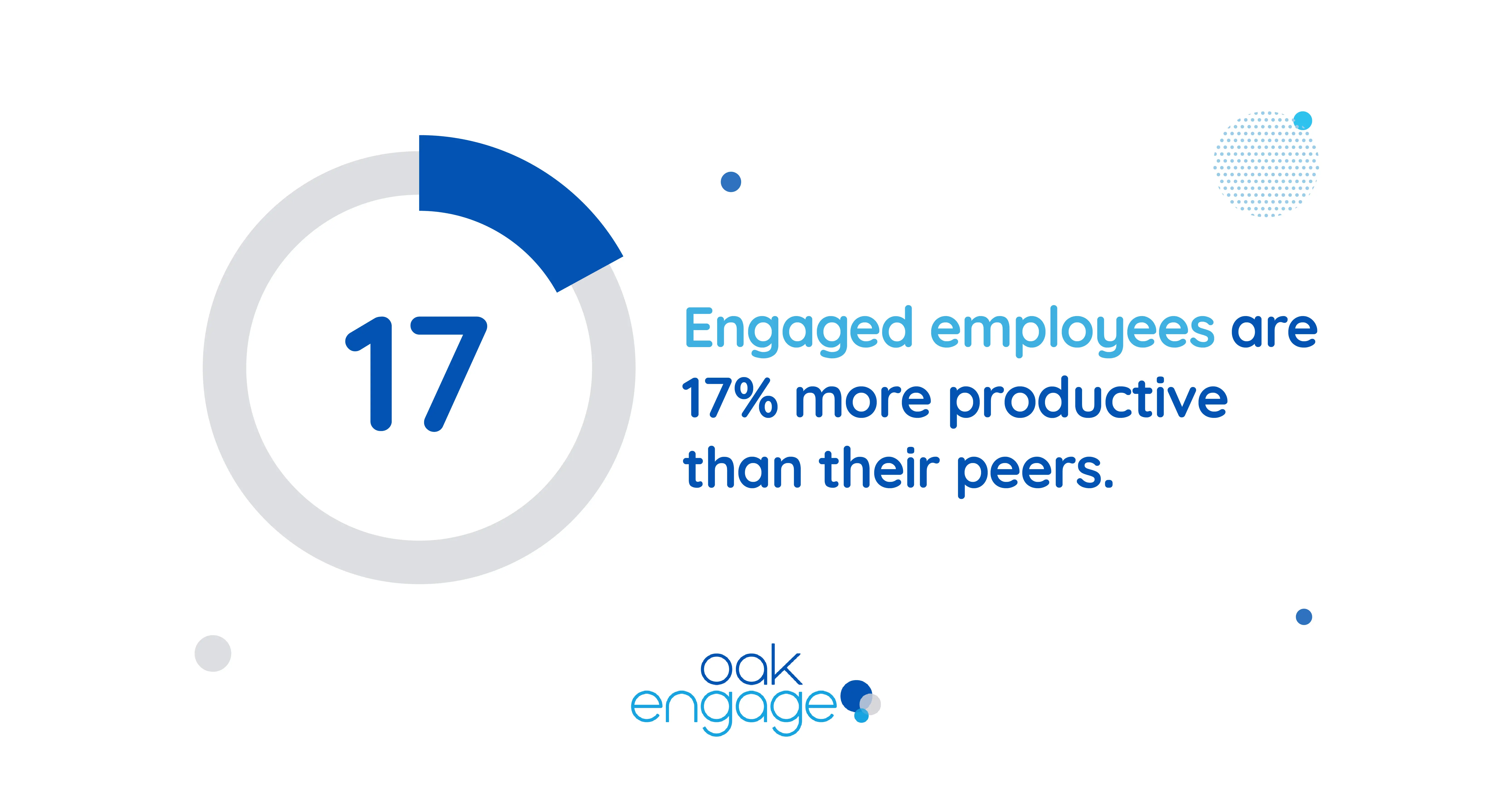
If that’s not a reason to start improving employee engagement, I don’t know what is!
Lower Absenteeism
Did you know that engaged employees are more invested in their job and care about the success of the business?
No? Well there’s more...
They are also firmly committed to their organisation's mission, and they're going to arrive every day with the intention to make sure it gets done.
In fact, highly engaged workplaces saw 41% lower absenteeism!
In fact, taking the occasional day off can be a sign that employees are engaged. They feel secure in their role, and they're confident one missed day won't affect their workload.
However, you should be concerned about engagement levels when patterns of absenteeism begin to develop.
The Link Between Employee Engagement and Staff Retention
Wondering why we’re talking about engagement and staff retention?
Well, engagement and retention are interconnected and can determine the success of an organisation.
When employees are not engaged at work, they have little incentive to say.
Even pay increases often can’t keep an employee who is not engaged, especially if they don’t see a promising future that includes satisfying work and a clear development path.
Gallup’s State of the American Workplace report captures the link between engagement and retention in a nutshell:
“Employees who are engaged are more likely to stay with their organisation, reducing overall turnover and the costs associated with it. They feel a stronger bond to their organisation’s mission and purpose, making them more effective brand ambassadors. They build stronger relationships with customers, helping their company increase sales and profitability.”
The same report found that only one-third of workers are engaged, which should be a red flag for most organisations.
Thankfully, there are actions you can take that have been proven to improve engagement and retention.
How to Improve Employee Engagement
1. Improve Efficiency in the Workplace
Are you working with outdated technology and inefficient practices?
Chances are the quality of your work and staff is going to be affected.
Recent surveys have identified that inefficient processes waste up to 26% of an employee’s working day.
That’s over a quarter of the day wasted! Crazy, right?
The big question is how can we improve this?
It’s not as hard as you think...
By making sure an efficient content and document management process is in place, an employee’s workload is made much more manageable and easier to handle.
Uniform processes maintain a defined quality of work, instead of having to cut corners due to time constraints.
You will most likely benefit from an intranet solution that allows you to store your important documents securely, in one place. Enabling users to locate all content, past or present, quickly and there's no more wasting valuable time searching for important documents.
We’ve designed Oak to find whatever you need instantly, helping your employees save time and be more productive.
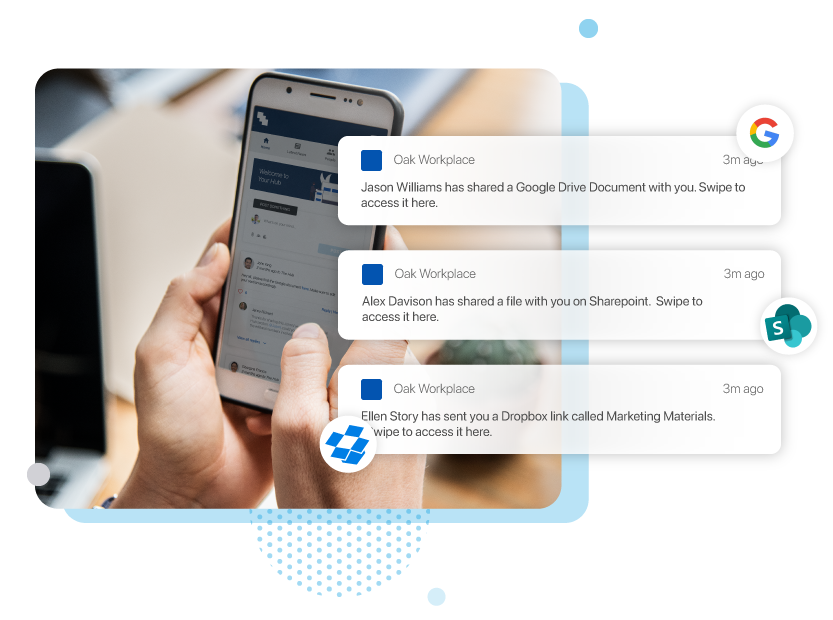
2. Improve Communication
When considering the notion of how to improve employee engagement, communication is one of the most important factors to bear in mind.
After all, communication is integral to our everyday lives, especially in the workplace!
It determines how effectively we fulfil our daily tasks and how we engage with colleagues.
Maybe you’re seeing increased miscommunication between your employees.
Especially if you’re a large organisation or enterprise.
This is probably due to staff unable to communicate with one another or they rely on outdated and inefficient processes to exchange information.
Of course, with less staff relying on desktop-based devices than ever before, facilitating communication for office based and deskless employees is vital!
Improving your workforce communication methods should be one of the first things to look at.
I bet you’re thinking, ‘this sounds fantastic but where do I start?’
👉Take a look at our 11 internal communication tools to facilitate better communication.
Give your employees a consistent and immersive experience by allowing them to access their company intranet wherever they are with Oak.
Ideal for organisations with deskless or remote workers - a mobile app powers communication and collaboration. It gives companies the power to access their intranet solution at any time, from anywhere.
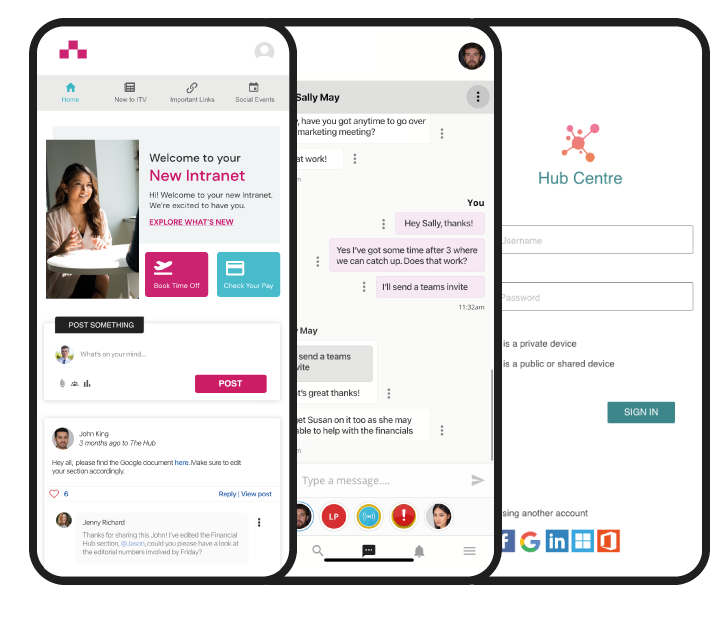
3. Give Recognition
Recognising your employees goes a long way to making your staff feel valued and increasing their productivity that little bit more.
Over 79% of Gen Z and Millennial professionals said that an increase in recognition and rewards would make them more loyal to their employer.
Not only will their motivation increase, but others will feel inspired to work for the very same recognition, ultimately boosting workplace morale.
So, how can you start?
Well, Oak’s employee recognition software helps companies boost morale and let their employees know that they care by celebrating milestones like birthdays, work anniversaries and achievements.
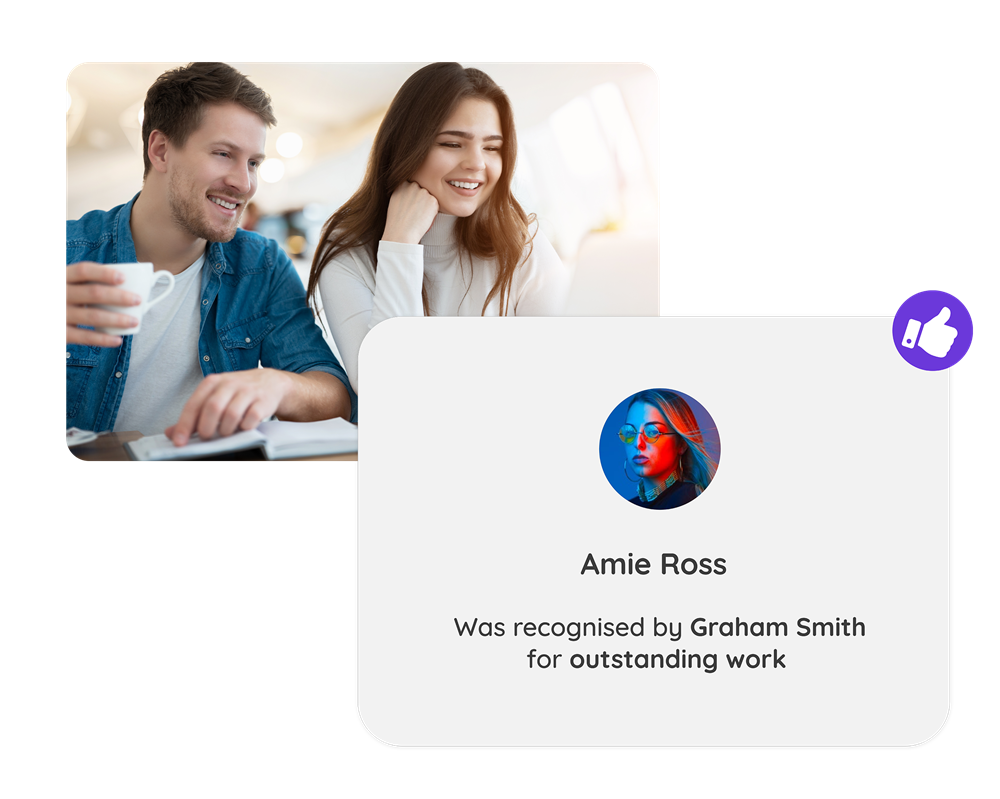
Employees can even comment on achievements at any time with Oak’s built in timeline.
This creates a positive working environment, which will in turn, boost morale, improve employee wellbeing and increase engagement and productivity.
Recommended Reading 📖: Employee Recognition in the Workplace: Complete Guide
4. Encourage Interaction
The workplace doesn’t always have to be about work.
In fact, building relationships outside of a professional environment can be an effective way of improving communication throughout your business as a whole.
By creating events or communities within your workplace, like minded people can solidify bonds with others from different departments and create relationships that may not have otherwise existed.
Who knew it could be so easy?
Oak’s hubs and communities bring like-minded people together, allowing your teams to share and collaborate on common interests.
Whether you need to share content company-wide, the latest user interface designs with a select group, or simply want a place to talk about the next social event.
Hubs on your company intranet allow employees to instantly connect and target the right people.
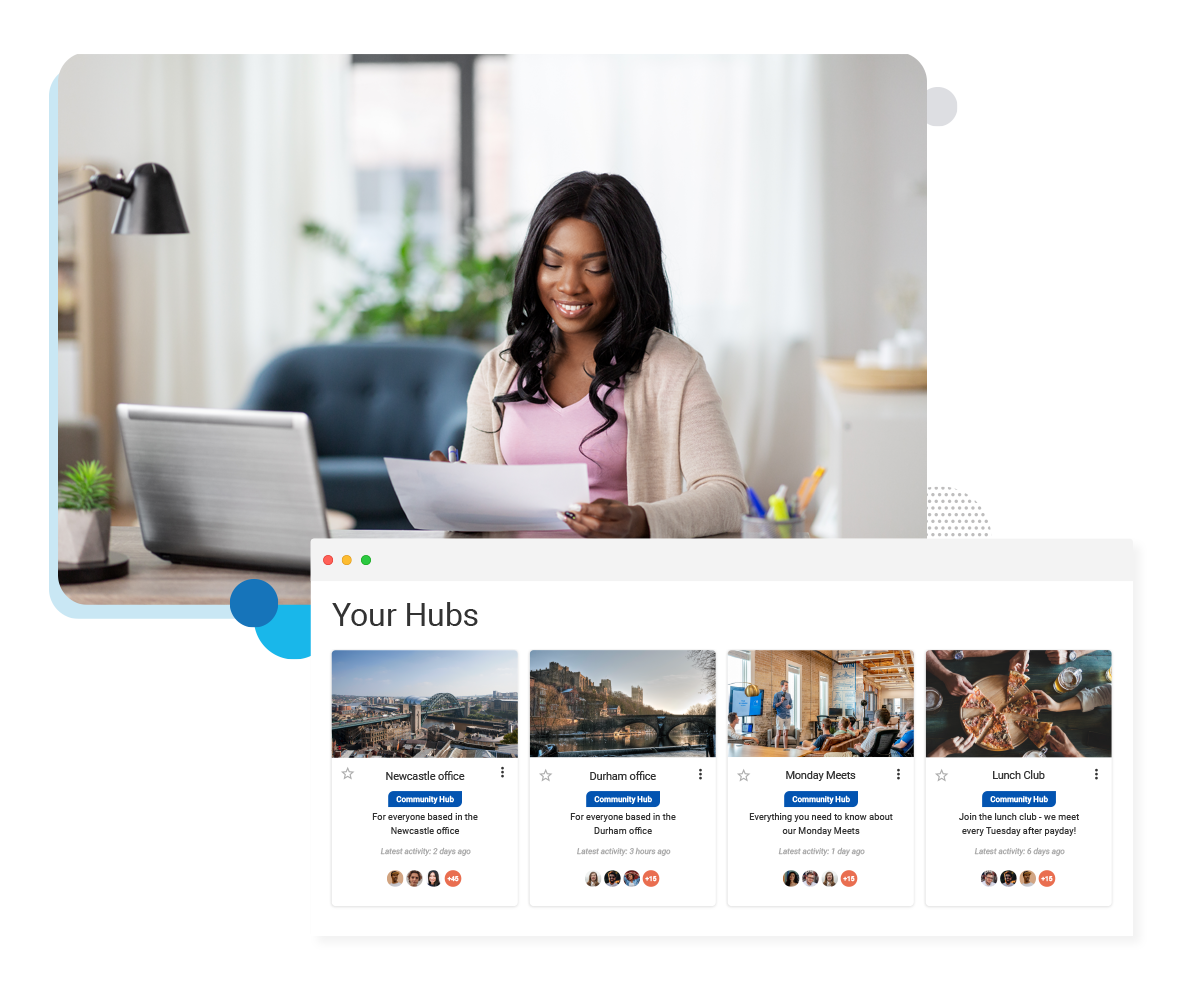
5. Invest in Your Employees, Invest in Your Company
Did you know that, if you don’t invest in the very things which your employees feel they are lacking, you could end up losing the engagement of your employees?
By putting aside a budget to cater to your employee's wants and needs, you are, in essence, investing directly into the company itself.
If you're unsure of what your employees need to boost their engagement and productivity levels, don't worry, we’ve got you covered.
You can quickly set up polls or Q&As within your Oak company intranet to gather feedback!
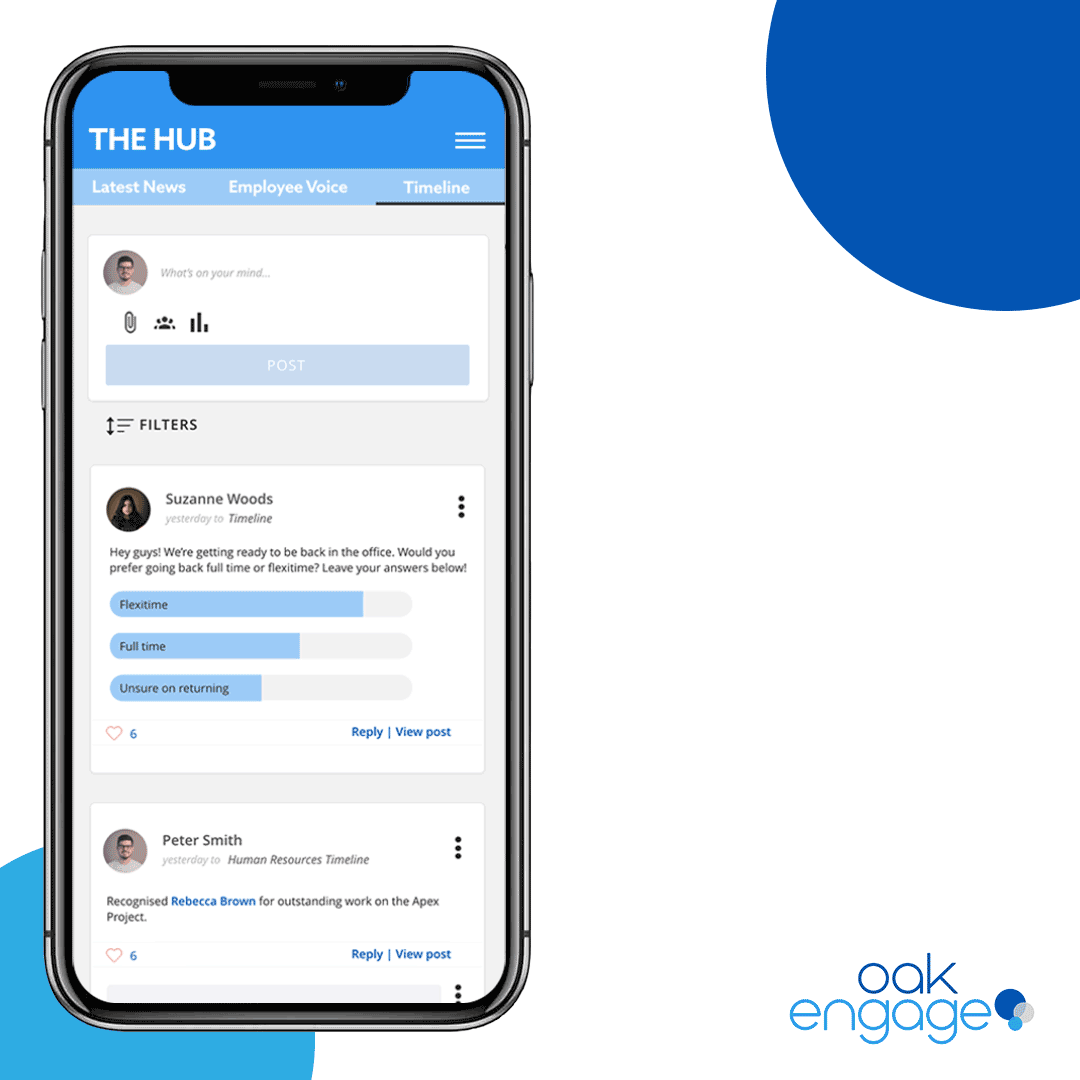
6. Focus on Employee Wellbeing
Employee wellbeing and engagement go hand in hand.
It’s far easier for individuals to engage with their work when the organisation makes an effort to enhance their overall wellbeing.
So, what can you do to shift your focus more towards employee wellbeing?
Firstly, a company-wide wellness initiative is a great way to improve employee engagement. Employees that feel valued and genuinely cared for by their business are much more inclined to return the favour.
At Oak, we understand that staying connected massively boosts employee wellbeing. Oak messenger is designed to improve employee engagement and workplace productivity.
Users can send instant messages to one specific person or a whole group. Perfect for department communication, remote workers and general social interaction between employees.
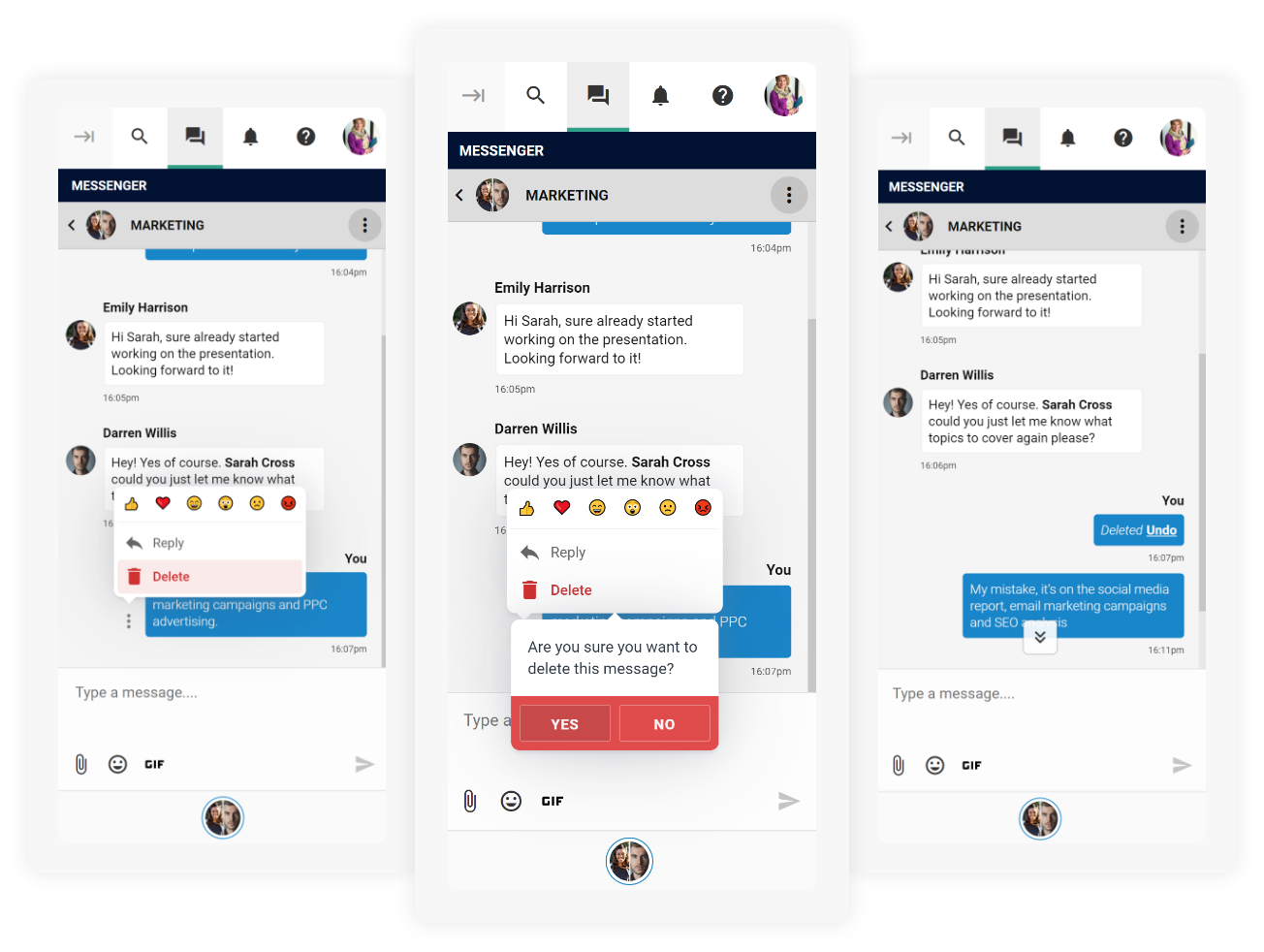
Recommended Reading 📖: Employee Wellbeing: A Beginners Guide
7. Encourage Feedback
More often than not, employees crave feedback. It boosts their level of workplace engagement and overall confidence.
More than 33% of workers still want more regular feedback, according to a survey by Joblist of over 1000 full-time employees.
Why not start by scheduling check-ins for each employee with their manager?
If you’d like to take it a step further, encourage middle management to establish regular review sessions with their team as an ongoing initiative to improve employee engagement.
While it may be tempting to implement a company-wide schedule for feedback, keep in mind that every team is different and frequent check-ins may feel unnatural to some.
So, what else can you do to gather feedback?
Well, Pulse Surveys are used to gather real, actionable insights that businesses can use to improve employee engagement, productivity and collaboration and enhance employee experience.
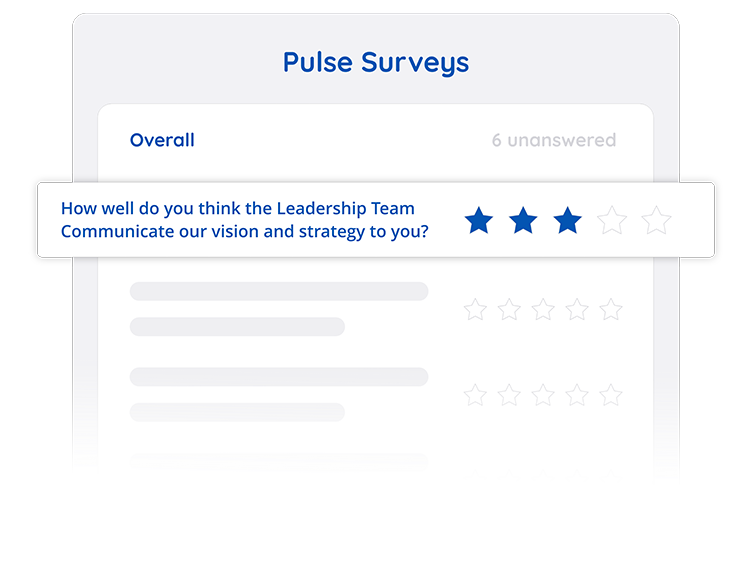
They allow businesses to gauge interest, understand an employee's opinion, gather feedback and more. Sounds great, right?
Recommended Reading 📖: Pulse Surveys: The Ultimate Beginners Guide
8. Emphasise Your Company Culture
Did you know that employees will be more engaged if they have a common goal and a shared culture.
Only 23% of executives say that their companies are excellent at aligning employees' goals with corporate purposes.
So, having a shared culture not only promotes consistency in the business, but also allows organisations to benefit from an open and friendly workplace.
A great company culture will also create a fun and engaging working environment that can result in a higher level of productivity and employee relations. Having a transparent work culture is vital to ensure that there is trust between management and employees.
But, emphasising your company culture doesn't have to be difficult.
In fact, you can communicate all company announcements on your intranet homepage.
Oak’s social timeline feature allows employees to catch up on the latest news and announcements or interact with colleagues through customisable content feeds.

Employees can comment, like, upload media and more. Timeline helps workforces to stay connected, engaged and aligned, promoting your company culture.
What more could you ask for?
9. Provide a Good Onboarding Experience
Onboarding is a pivotal moment for making employees feel included from day one.
It sets the tone at your company, laying the foundation for their knowledge of and experience working for your company.
This is why building an inclusive onboarding experience is so important to creating a great company culture and building engagement.
So, how can you go about building the best onboarding experience?
Your intranet is a crucial platform for onboarding new employees.
Many of our features’ personalise the digital workplace experience for all employees.
It’s also important for a business to make it quick and easy for employees to learn as much about their colleagues and organisation as possible. Our people directory creates a seamless onboarding experience, improving engagement from the start.

10. Give Working Flexibility
Flexible working is quickly becoming the ‘new normal, don’t you agree?
Flexible work schedules and remote work opportunities are almost guaranteed ways of increasing employee engagement.
This kind of flexibility caters to the elusive work-life balance employees crave.
87% of employees expect their organisations to support them in balancing work responsibilities with personal commitments.
Why not provide your employees with the ability to adjust their work hours to accommodate their personal needs? This shows that you value your team members on a personal level.
Again, use your intranet to adjust your working times or mark a day off. An intranet calendar is important for employees to stay organised to track meetings, appointments, events, birthdays or who's out of the office on a certain day.
Connectivity and accessibility is at the heart of any great intranet, so companies will want calendars that can be shared among team members and other departments.
After all, you want everything you need, all in one place.
To summarise
Retention is a real issue that should be addressed in the workplace, especially if you’re already seeing high turnover rates.
Increasing employee engagement can help improve retention and provide the benefits of better productivity and employee satisfaction.
Focus on your company culture and take proactive steps to improve engagement.
If you would like to find out how Oak can help you improve employee engagement, get in touch.
Alternatively, why not download your own employee engagement action plan template to get your engagement planning off to the best possible start.
